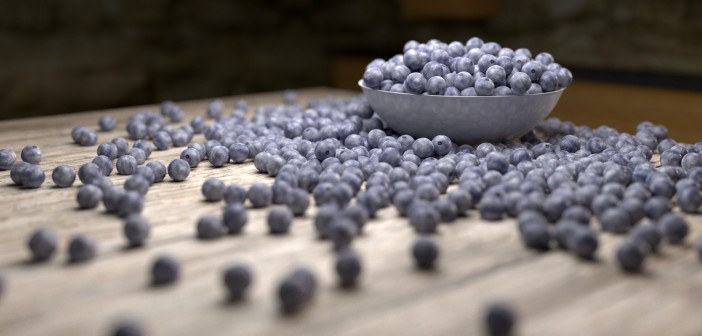You may have seen the results of Paul McManus' 'Render a Day' project on Twitter - for a year he posted one Blender image a day in an effort to deepen his understanding of Blender. Today speaks about his experienced and how it helped him become a better artist.
In September 2013 I was asked to join with some friends to do a photo-a-day challenge where each day I would be expected to post a picture, based on a previously decided theme per day. I decided, for various reasons, to do something different and try to create a Blender scene each day with the rendered image linked in some way to the day's theme. Twelve months later I have posted 365 images of scenes modelled in Blender and rendered using Cycles.
Over the intervening period I have been asked by several people what am I doing, why am I doing it and have there been any benefits.
I am a firm believer that life is an education and that we never stop learning. What seems to happen is that the rate at which we learn new things varies depending upon our need and determination at different moments in time. Invariably, learning new skills with very loose aims can be a slow process. In my experience learning while trying to solve a problem or with a well defined objective appears to commit the new material more firmly than without either of those things.
When I started this project I was twelve months into learning to use Blender and had just decided to make the switch from the Blender Internal renderer to using Cycles, so lots of new stuff to learn. I also realised that I had a comfort zone which was probably only covering about 15-20% of the functionality Blender had to offer. I decided that I needed to get out of this zone, develop a wider set of skills covering more of the features of Blender and try some more ambitious scenes. The photo-a-day idea seemed perfect as a way of pushing me down that road. I decided on a few rules for consistency and also so that I could retain some of my sanity during this period. All the scenes would be rendered at 1920x1080; average time spent working on a scene (excluding rendering) would be two hours; photographs are allowed as HDRi images, backdrops or textures; assets created in one scene could be reused in a later scene. All that was fine, but in practice over time the two hour rule became a little fuzzy, I would say that the time varied between 1 hour and about 12 hours for some scenes - if I had the time. Also, as I did most of this work in the evenings, overnight renders happened quite frequently.
So what did I learn? Quite a lot in fact.
- My skill set improved. As you would probably expect, but in two ways. Now I can do more - some things I avoided in the past I will now happily incorporate into a scene e.g. volumetrics. I can do some things more quickly - because I know better and more efficient ways to reach a specific goal and also because I am more comfortable with the user-interface.
- My planning has improved, particularly with regard to modelling. I used to adopt a bottom-up approach where I would block out a scene or object and then start modelling the detail in one part hoping that I'd be able to eventually cover the whole scene. Sometimes this didn't work and there would be a degree of backtracking before I reached the end. Even when it did work it sometimes resulted in poor geometry/topology. Now I use a more top-down approach where I defer final detail until later in the process. Delaying things like application of modifiers and introduction of loop cuts, for example, keeps the model more flexible.
- Learning when to stop. One problem that a lot of artists have, in my opinion, is deciding when a piece is finished. Some of my early work had considerable amounts of tweak and twiddle that did little or nothing to improve the result. Having a daily deadline meant I had to be pretty ruthless in deciding when a particular scene was finished. That didn't always mean I was happy with the result. What it often meant was that my estimate for effort and time to take the scene to the next milestone for improvement took it outside of the available time. I am hoping this will make me a better estimator when trying to schedule future work of this kind.
- New skills. I tried whenever I could to try and touch upon a new feature of Blender (new to me at least) when the opportunity presented itself. This was occasionally difficult as the documentation was, at times, sparse and the quality of tutorials varied considerably. None of this was wasted time but some things did seem to take substantially more time than I would have expected to achieve even modest results e.g. cloth simulation.
- Implications for work. During the year I was able to take on an animation job, several product pre-visualisation jobs and some website graphics which I probably couldn't have done, at least economically, prior to starting this project.
Any downside? Of course there were some difficulties. Time management was probably my biggest issue - trying to have images ready each day to post and still have a "normal" work and home life was occasionally difficult. Days when I was away from home and my computer meant I had to stockpile a few images beforehand. Also, towards the end of the year as I was setting more ambitious goals for each of the day's themes I felt that the time constraints meant I wasn't able to create the scenes that I would have liked.
For anyone thinking of doing something along these lines then there are two aspects of this that I can recommend - the first is to create something and post it to the web on a regular basis. If you do this in the right forums it will get people's attention, make you friends and get you feedback. A picture a day is quite a tall order and might be difficult for some to fit into their hectic lives, once every week or two though would still be beneficial. Be consistent though. The second is to use a brief, or subject matter, that you don't decide yourself. In my early work I chose what I did and it is pretty obvious I just stayed within my comfort zone repeatedly using the same skill set. The picture a day themes definitely made a difference. They developed my ability to be creative, research ideas, made me more resourceful and change the way I looked at the world. For example, now, whenever I go out on a trip with my camera, I'm also looking to take pictures of textures I can add to my library.
My conclusion is that it was a worthwhile project. It served its purpose, which for me as an independent developer and artist meant I had some staff development, something that was lacking from my earlier solo career. I have learned a lot. In addition, I now have the basis of a portfolio and a body of work to show potential clients. I am very glad I did it but now I'm ready to move on to larger projects.









10 Comments
inspiring
Very impressive! So, if you don't decide the theme yourself then who does? i.e. is there a website that provides it? Would be useful for those rare occasions when I have some time to spare :-)
Thanks Tom. I was challenged to use these themes http://fatmumslim.com.au/november-photo-a-day-2014/ There are quite a few of these lists out there, mainly related to photography.
The weekend Challenge on the blenderartists website have helped me to improve my skill set and I have had a great deal of fun doing it.
http://blenderartists.org/forum/forumdisplay.php?17-Weekend-Challenge
Each week a theme is given that is chosen by the previous weeks winners.
Similar to what happens here on blendernation.
I am unable to do a render a day right now, at least of any quality, but trying to be consistent has many benefits.
Thanks for sharing your experience, Paul.
Thanks Paul - will bookmark that:-) I keep meaning to have a go at the weekend challenge, but never have the time at the weekend - have a todo list of major projects, so smaller stuff tends to get pushed out:-( Did start one time, but bit off more than I could chew and didn't finish:-/
Too true! And after 8 hours/day 5 days/week at my PC at work, I've virtually given up using my PC at home at the weekend. Blender is my 'lunchtime' project at work (OK, that's sometimes a very long lunch time!). The OP said "...but some things did seem to take substantially more time than I would have expected to achieve even modest results...". True again. Try animating fluid pouring into a thin walled plastic bottle - almost impossible even after 3 hours hair-tearing. Resolution needs to be so high to get good results, and the fluid still escapes through the walls of the bottle!
Yeah - finding the energy is hard:-/ Regarding the thin walled object problem there is a trick there - have two copies of the object - one with thick walls, one with thin walls. You render the thin walled version whilst colliding the thick walled version. I once animated a saline bag that way - with zero thickness walls! Can also help to use the shrinkwrap modifier on the fluid mesh after the simulation to prevent it intersecting the wall, and keep a small air gap to avoid rendering glitches.
Great article. Very Inspirational!
Great job Paul, I really liked seeing this at Bcon. Glad you got a writeup here :D I'll have to do try my hand at a challenge over Christmas. Keep up the good work!
I think this is something any artist can implement to improve their skill sets. I'll do this occasional on a short term basis just to push myself on the composing side. This post is a good reminder for me to keep pushing myself. Thanks!